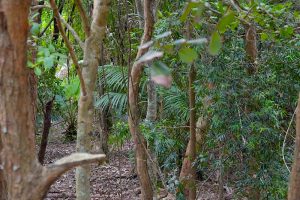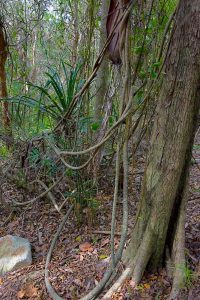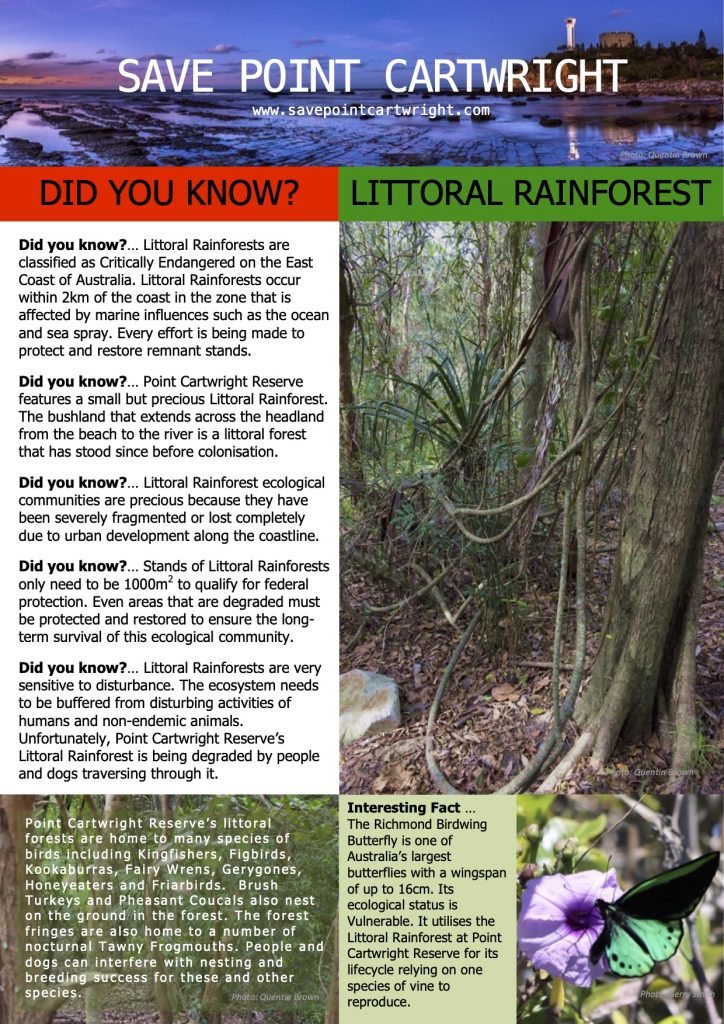Point Cartwright Reserve’s Littoral Rainforest
The Point Cartwright Reserve has a Littoral Rainforest vegetation community within some remnant stands pre-dating colonisation. In accordance with the EPBC Act classification system for Littoral Rainforest and Coastal Vine Thickets of Eastern Australia, this ecological community is rated as nationally significant and Critically Endangered along the eastern seaboard of Australia. In accordance with the EPBC Act, this ecological community must be protected from stressors and restored wherever possible.
At Point Cartwright Reserve, this ecological community has been in severe decline due to decades of government policies and management practices that have allowed intensification of recreational uses to interfere with forested areas and more recently carry on within the forested areas without adequate protection measures. Consequently the viability, integrity and condition of the forest are in rapid decline. Dog off-leash areas have been intentionally designated across remnant stands of this forest allowing free roaming dogs to trample the understory and interfere with nesting birds. Humans are increasingly traversing through the forested areas as the forests have become easier to traverse due to degradation, compounding the problem further. People (and their dogs) are increasingly taking short cuts and conducting recreational activities within the forested areas, leaving a growing amount of waste, plastics and glass. Other anthropogenic activities such as parties with fires have been occurring within and adjacent to forested areas as well.
As described by the EPBC Act’s Littoral Rainforest and Coastal Vine Thickets of Eastern Australia provisions, Littoral Rainforest ecological communities occur within 2km of the coast, on coastal headlands, dunes, sea-cliffs or other places influenced by the ocean, sea spray and other maritime influences. An ecological community is an assemblage of species which can include flora, fauna and other living organisms that occur together in a particular area. Given the small area of this ecological community remaining in Australia, all sites that meet the EPBC Act criteria are to be considered as habitat critical to the survival of the ecological community. To satisfy the criteria for classification and protection under the EPBC Act, the size of the strand only need be 0.1 of a hectare in size (1000m2). This is indicative of how seriously the conservation and restoration efforts for this endangered community are being taken at the national level.
The national listing of an ecological community recognises that its long-term survival is under threat. Littoral Rainforests have been listed under the EPBC Act based on a number of factors including that it is fragmented, has small patch sizes coupled with demonstrable threats, and the reduction in the integrity of the ecological community make it critically endangered. The listing aims to prevent any further decline and to promote and assist recovery through government, landholder and community efforts. The structure typically includes a closed canopy of trees, but the canopy can be patchy when in exposed situations, after storm events or due to anthropogenic influences. Usually, several vegetation layers are present. The canopy protects less tolerant species underneath it from salt-laden winds. However, where there is extreme exposure to salt laden winds, these distinct layers demonstrate a height continuum. Moreover, wind sheared canopy can be present on the frontal section (closest to the sea).


